This article dives into various reinforcement strategies in Applied Behavior Analysis (ABA) that can help encourage positive behavior in children. We’ll explore methods like token economies, verbal praise, and tangible rewards, and highlight how important caregiver involvement is. By tailoring these reinforcement approaches, we can significantly boost motivation and pave the way for lasting behavioral improvements.
Let’s take a moment to think about the challenges we face as parents. It can be tough to know what works best for our kids, right? But don’t worry! With the right strategies, we can make a real difference. Together, we can explore these ideas and find what resonates with your family's unique needs.
Remember, we’re here to help you every step of the way! 😊
The journey toward positive behavior change in children can often feel daunting. Yet, it’s also filled with wonderful opportunities for growth and connection! By harnessing the principles of Applied Behavior Analysis (ABA), caregivers can create tailored reinforcement strategies that not only motivate children but also resonate with their unique interests and needs. As families navigate these methods, questions naturally arise:
In this article, we’ll delve into ten impactful ABA reinforcement examples designed to encourage positive behavior. Together, we’ll explore insights and practical applications that can transform everyday interactions into powerful learning experiences. Let’s explore this journey together!
At Rori Behavioral Innovations, we truly believe in the power of tailored support strategies in ABA therapy. By conducting thorough assessments, like Functional Behavior Assessments (FBAs), our clinicians can identify the unique needs of each individual and pinpoint triggers for challenging behaviors. This thoughtful approach leads to the creation of customized support strategies that not only boost engagement but also ensure that the incentives resonate with the young person, significantly increasing the chances of positive behavior change. For example, if a child loves dinosaurs, earning dinosaur stickers can serve as ABA reinforcement examples for completing tasks—making the reward both fun and effective!
Moreover, we see remarkable progress in 90% of children when recommended hours are fully implemented with active participation from caregivers. When family members join in the reinforcement process, they help build a strong support system that aligns with therapy goals. After each session, our behavior care engine adjusts behavior intervention and skill acquisition plans based on the progress made, creating a nurturing learning environment that inspires children to engage more actively in their therapy and everyday activities. Caregivers gain valuable insights through education, deepening their understanding of ABA principles and strategies, which enhances their ability to support their child's growth effectively. We encourage parents to consider how they can apply these tailored support strategies at home—like using verbal praise or offering access to favorite activities—to further enhance their child's engagement and success. Let’s explore this together!
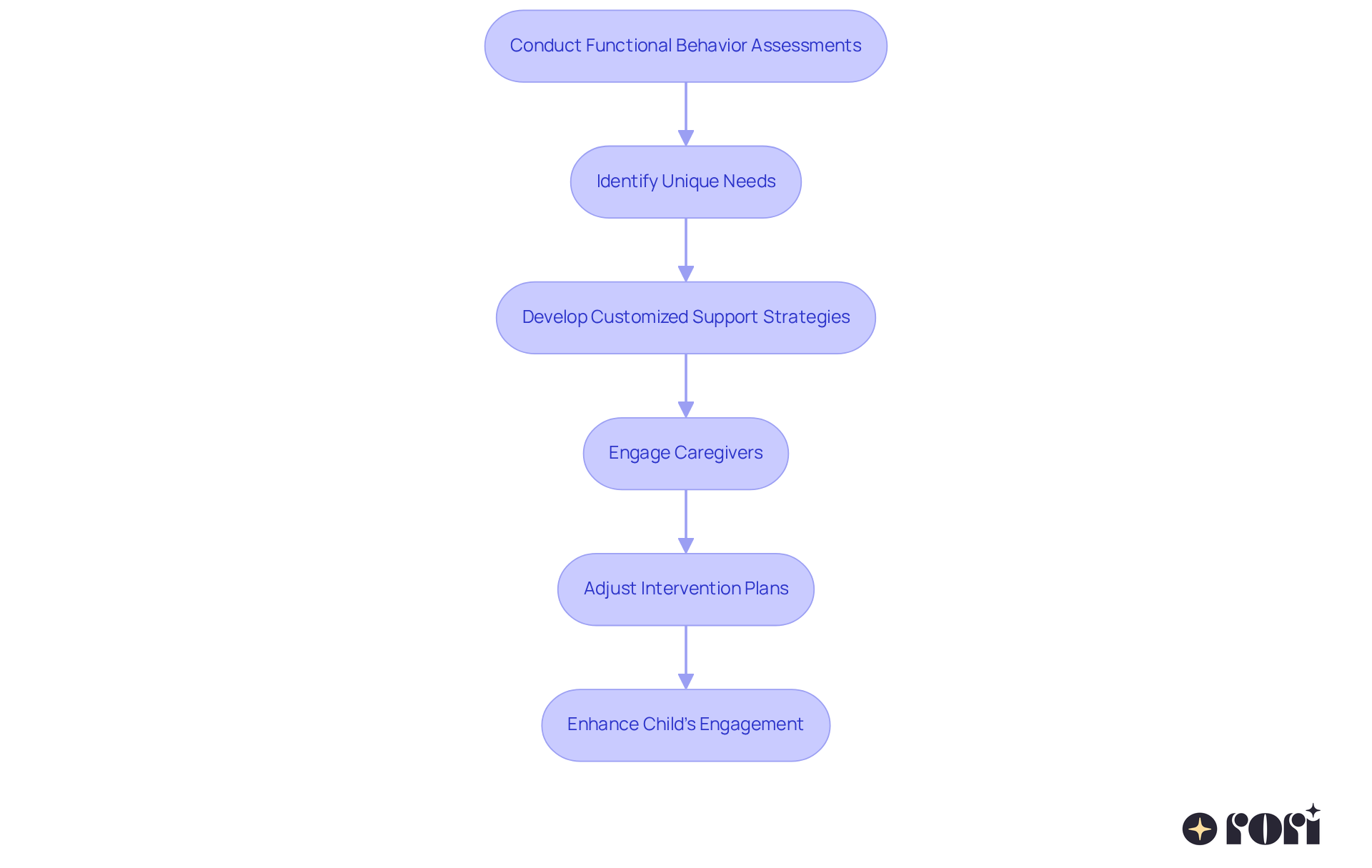
A token economy system is a structured way to encourage positive behavior in kids. Think of it as a fun game where children earn tokens for showing good actions, which they can later trade for cool rewards like toys or extra playtime. For instance, a child might earn a token for every five minutes they stay focused, which they can redeem for their favorite activity. This not only motivates kids to engage in positive behaviors but also teaches them valuable lessons about delayed gratification and goal-setting—skills that are essential for their growth.
Research shows that ABA reinforcement examples, particularly token economies, can really boost motivation and engagement, especially for children with autism and ADHD. By providing immediate feedback and a clear connection between their actions and rewards, these systems help kids feel accomplished and build their skills. When implemented successfully, children can improve their social interactions and academic performance through this structured reinforcement.
Concrete incentives work wonders as motivators for behavior change because they are appealing and easy for kids to understand. The beauty of token economies lies in their adaptability; they can be tailored to fit each child's unique preferences, making sure the rewards resonate with them. This personalization is key, as it keeps kids engaged and helps prevent token satiation, which is when they might lose interest in the tokens over time. To counter this, caregivers can set up reinforcement schedules, outlining how often tokens are given and what kids need to do to earn them.
Parents can also boost the effectiveness of token economies by using ABA reinforcement examples, including modeling desired behaviors and tracking progress with data collection. For example, creating visual charts to showcase earned tokens and rewards can reinforce the link between effort and achievement. Plus, emerging trends like virtual tokens and apps are modernizing these systems, making them even more appealing to kids. When caregivers understand ABA principles and strategies, they can better support their children in achieving their behavioral goals. When parents are engaged and informed, they create a consistent and nurturing environment that maximizes the benefits of this approach. Overall, when done thoughtfully, token economies can lead to lasting positive behavior changes and improved outcomes for children, making them a fantastic resource for both parents and educators. Let’s explore this together!
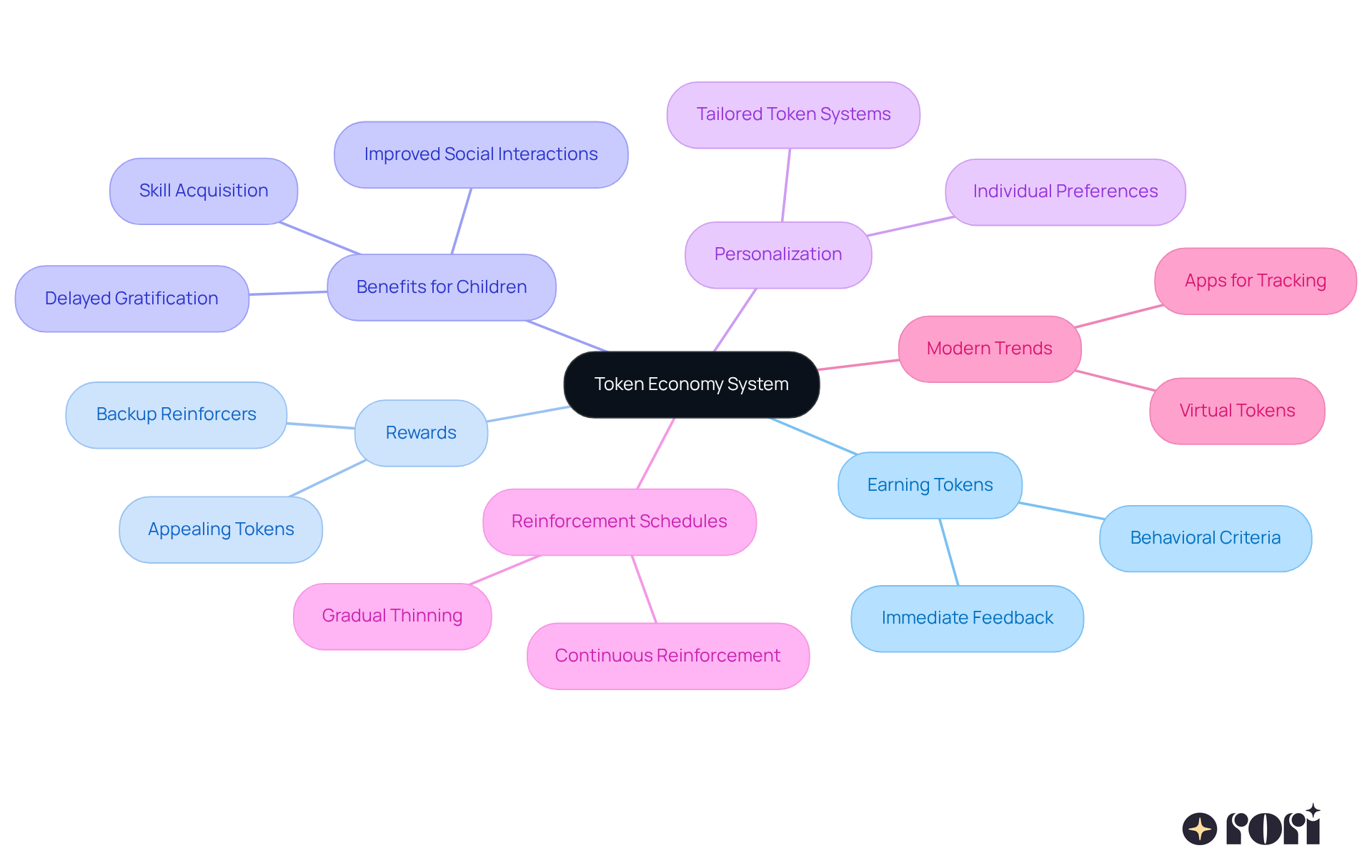
Oral commendation and validation are essential ABA reinforcement examples that provide constructive support in ABA therapy. This approach adapts to each young person's unique needs, using the principles of learning and behavior. When a child demonstrates positive actions, a quick verbal acknowledgment—like 'Great job sharing your toys!'—can really boost their motivation. This kind of ABA reinforcement examples not only builds their self-esteem but also increases the likelihood of those actions being repeated.
By using specific praise that clearly highlights the behaviors being rewarded, we provide ABA reinforcement examples to help kids understand exactly what they’re being recognized for. Research suggests that the ideal ratio of positive comments to criticism is about 5.6 to 1. This emphasizes how important regular positive feedback is in shaping behaviors. By creating an environment rich in targeted commendation and using ABA reinforcement examples, caregivers can effectively motivate youth with autism, guiding them toward positive behavioral changes.
To keep encouragement fresh and engaging, caregivers can mix up their phrases of praise. This way, their support remains impactful over time, making the journey a little more enjoyable for everyone involved. Let’s explore this together and see how we can make a difference!
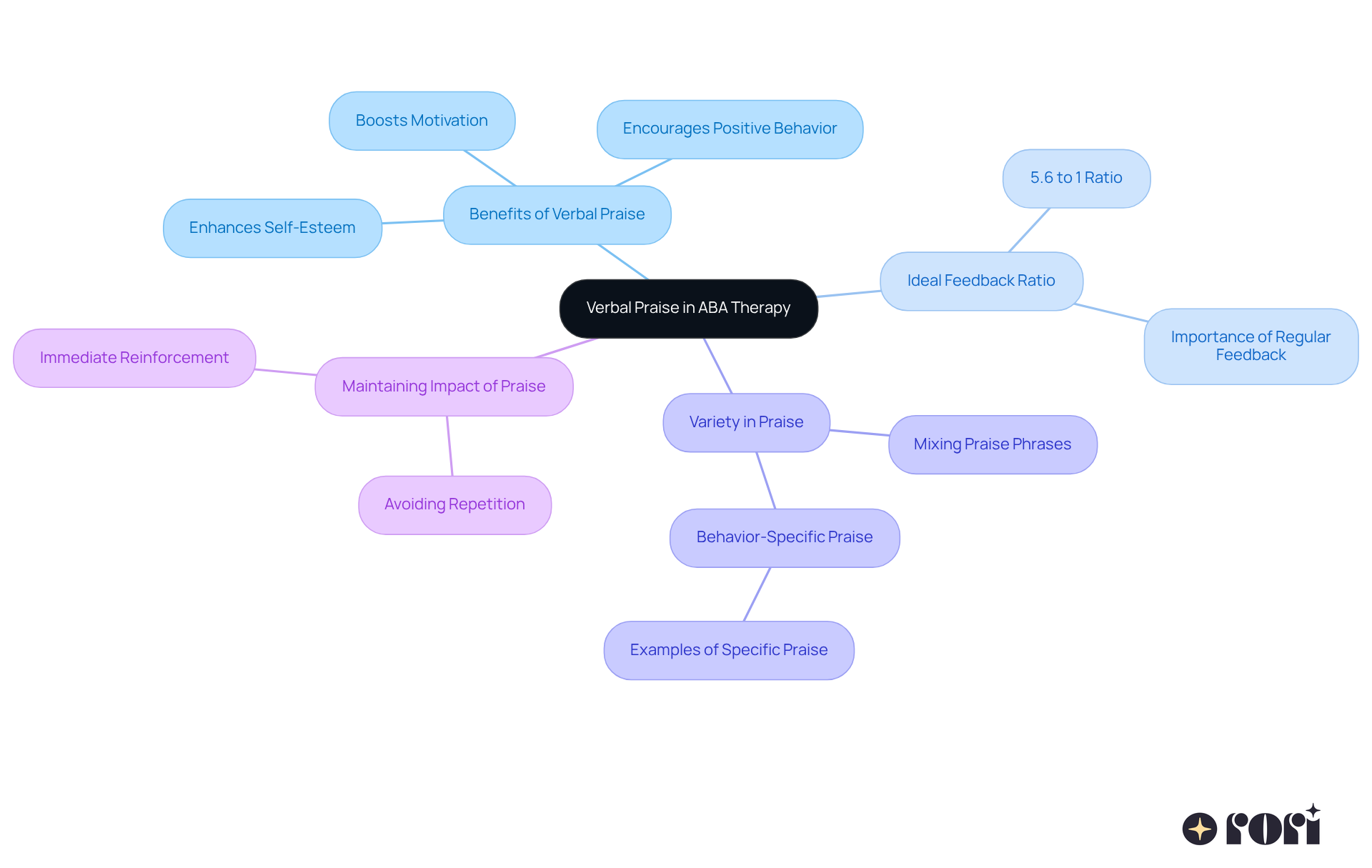
Physical incentives, like stickers, toys, or snacks, can be wonderful motivators for encouraging kids to take positive actions. Imagine a young person earning a small toy just for completing their homework on time! The immediacy of these rewards is key; it really strengthens the link between their behavior and the incentive, making it a powerful strategy demonstrated by aba reinforcement examples.
To make these incentives even more effective, it’s important that the rewards match the child’s interests and preferences. This personalized approach, utilizing aba reinforcement examples, not only boosts motivation but also creates a positive learning environment, encouraging kids to repeat those good behaviors. By consistently using these tangible incentives, children can develop essential skills and traits, leading to improved self-esteem and a greater readiness to face new challenges. Let’s explore this together and see how we can support our kids in their learning journey!
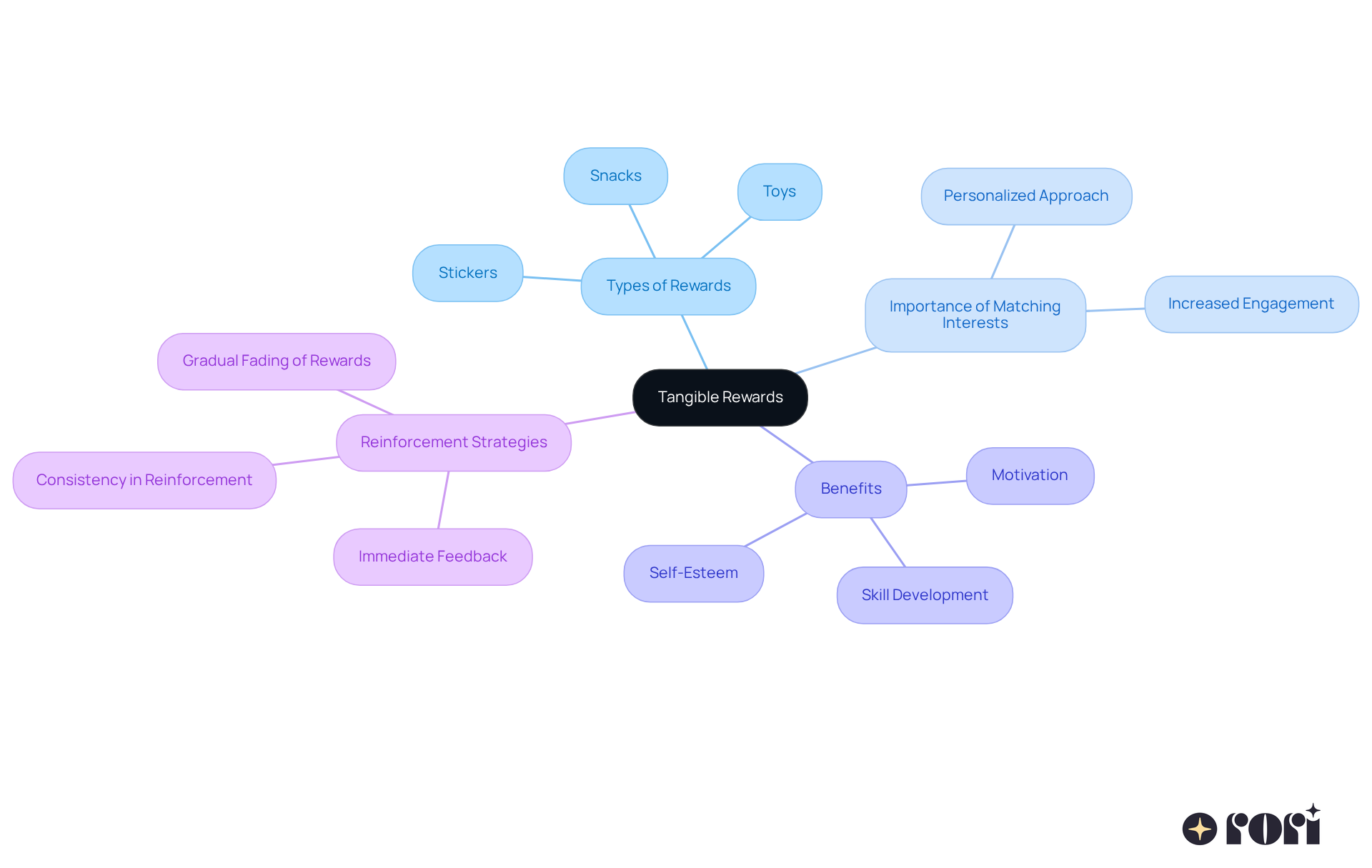
ABA reinforcement examples demonstrate how powerful social reinforcement can be in Applied Behavior Analysis! It uses social interactions—like smiles, high-fives, and verbal praise—to encourage positive actions. For instance, when a little one shares their toys, a caregiver can respond with enthusiastic praise and a warm smile. This kind of positive social feedback really reinforces those actions. Not only does it inspire the child, but it also helps develop essential social skills and relationships, which are illustrated through various ABA reinforcement examples, making it a vital part of ABA therapy.
Research shows just how significant social interactions can be in changing behavior. Psychologists who specialize in working with kids emphasize that when young individuals engage in meaningful social interactions, it can greatly boost their motivation and willingness to participate in preferred behaviors. For example, one study found that children who received social support during language interventions showed higher levels of social involvement and improved communication skills.
You can see successful uses of social encouragement in various settings. One young individual, who initially had limited social involvement, made remarkable progress when social interactions were included in incentive strategies. This child, who was once hesitant to join in, began initiating interactions with peers after receiving consistent social praise for their efforts. How wonderful is that?
Current research highlights that incorporating social interactions as ABA reinforcement examples not only encourages positive behavior but also nurtures a sense of belonging and acceptance, especially among individuals with autism. By creating an environment where social interactions are valued, caregivers and educators can significantly influence a young person's development. This paves the way for improved social skills and emotional well-being. Let’s explore this together!
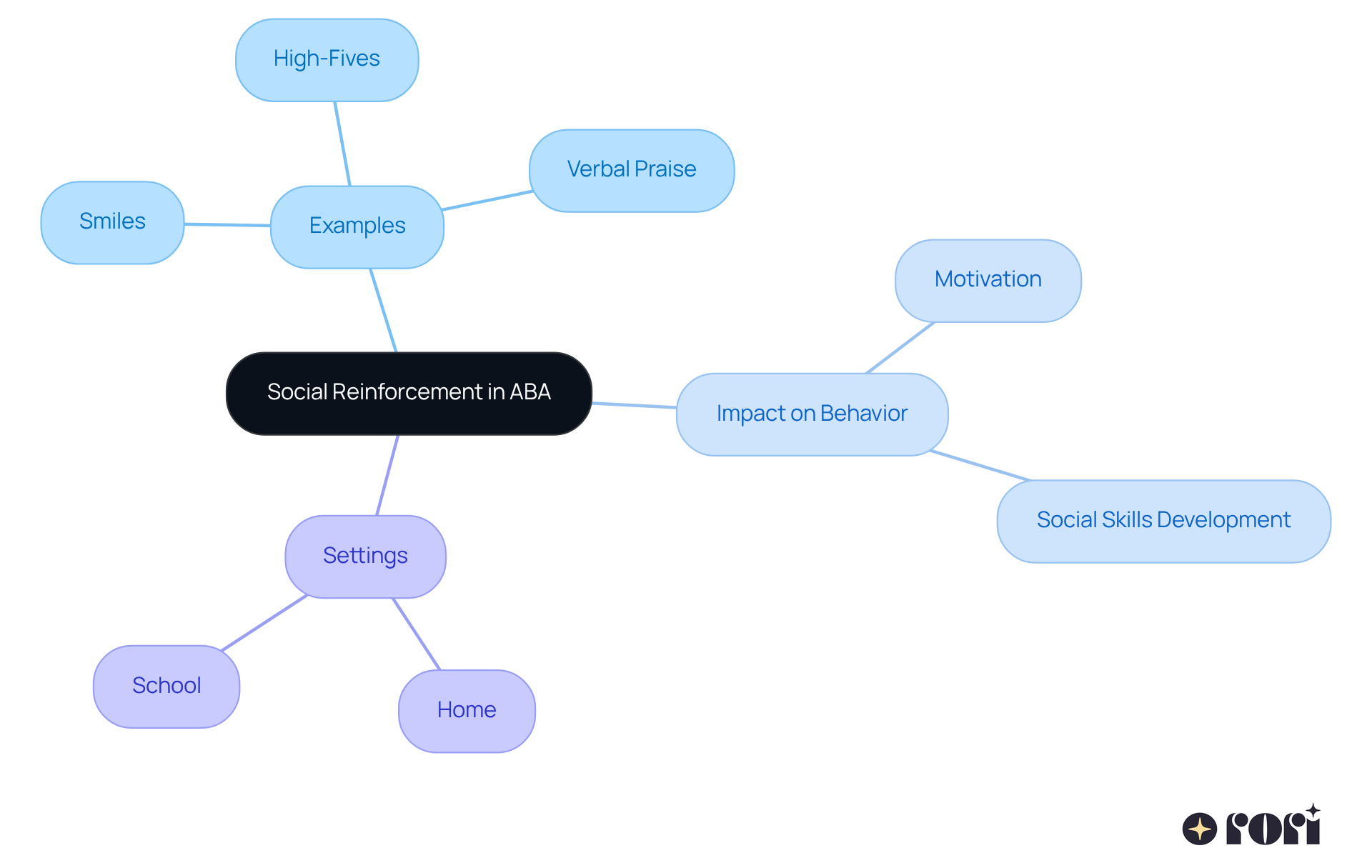
Natural reinforcers serve as intrinsic rewards that come directly from a young person's actions. For instance, when a child helps tidy up their toys, they might feel the joy of a neat space or get the chance to join a new game afterward. By tapping into these natural reinforcers, caregivers can help children appreciate the intrinsic value of their positive actions. This recognition fosters a sense of achievement, encouraging them to repeat such behaviors in the future.
The impact of these inherent incentives goes beyond just immediate satisfaction; they inspire lasting changes in behavior by nurturing a deeper understanding of the benefits tied to positive deeds. Imagine a child who feels proud of their organized area—this pride makes them more likely to engage in similar activities, creating a cycle of positive actions and outcomes.
When we effectively utilize intrinsic rewards, we not only boost a young individual’s motivation but also cultivate a lasting commitment to positive behaviors. This ultimately supports their growth and independence. Let’s explore this together and see how we can make the most of these rewarding moments!
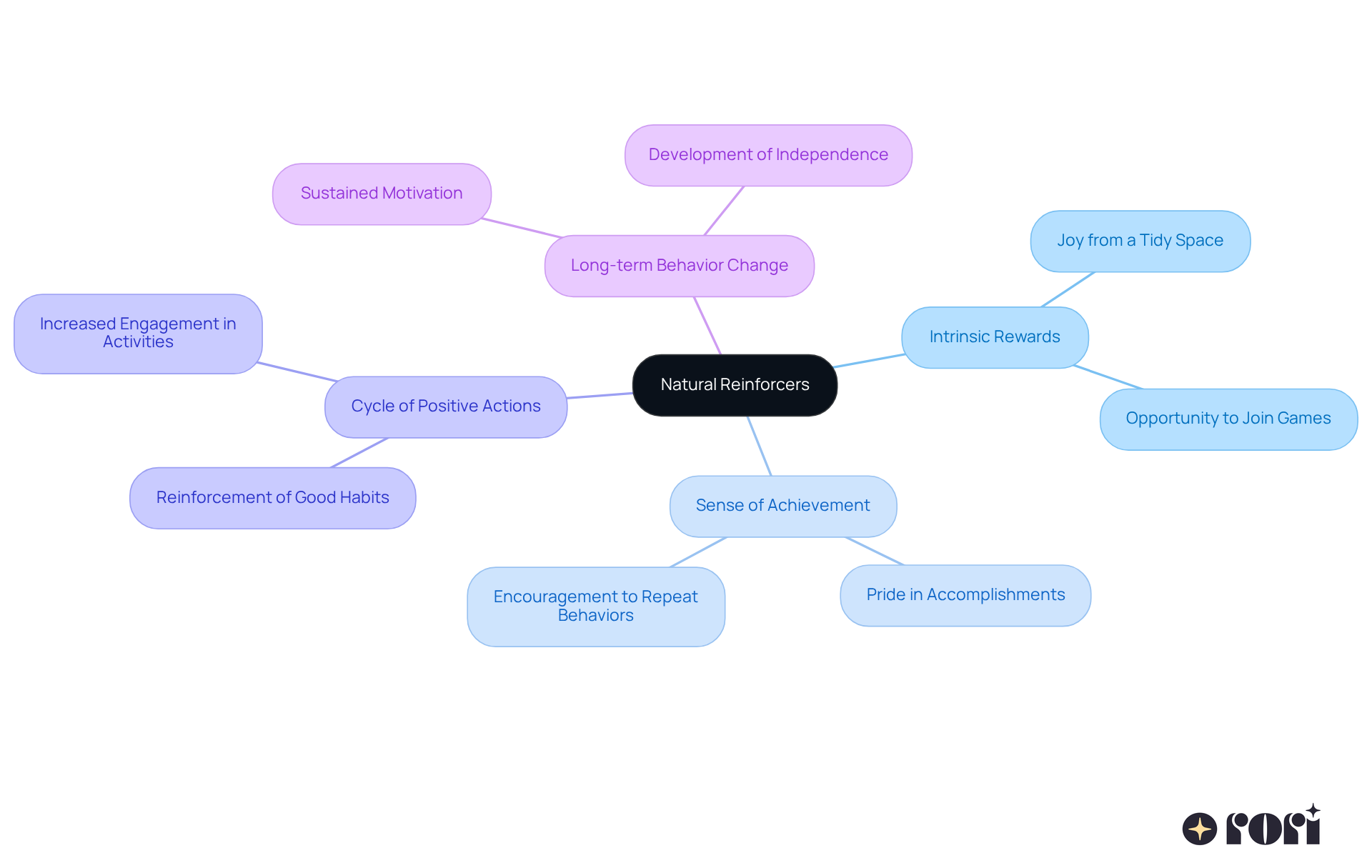
ABA reinforcement examples illustrate how differential reinforcement is a vital technique for shaping behaviors by rewarding desired actions while withholding rewards for undesired ones. Imagine a young child learning to ask for a break instead of throwing a tantrum—when caregivers support this request and ignore the tantrum, it teaches them what behaviors are acceptable. This approach not only guides young ones toward positive actions but also motivates them to replace negative behaviors with better choices, illustrating several ABA reinforcement examples that lead to more effective behavior management.
Active involvement from caregivers is key in this journey. It not only enhances professional interventions but also ensures consistency at home. Research shows that when suggested hours are applied with active caregiver participation, we see significant improvements in 90% of children! By understanding the principles of ABA and its strategies, caregivers can apply ABA reinforcement examples to make informed decisions that positively influence their child's development, paving the way for better behavioral outcomes.
And let’s not forget about the conduct care engine! This tool makes things even smoother by updating intervention and skill acquisition plans after each session based on the progress made. It’s all about supporting each other in this process. So, let’s explore this together and empower ourselves in our roles as caregivers!
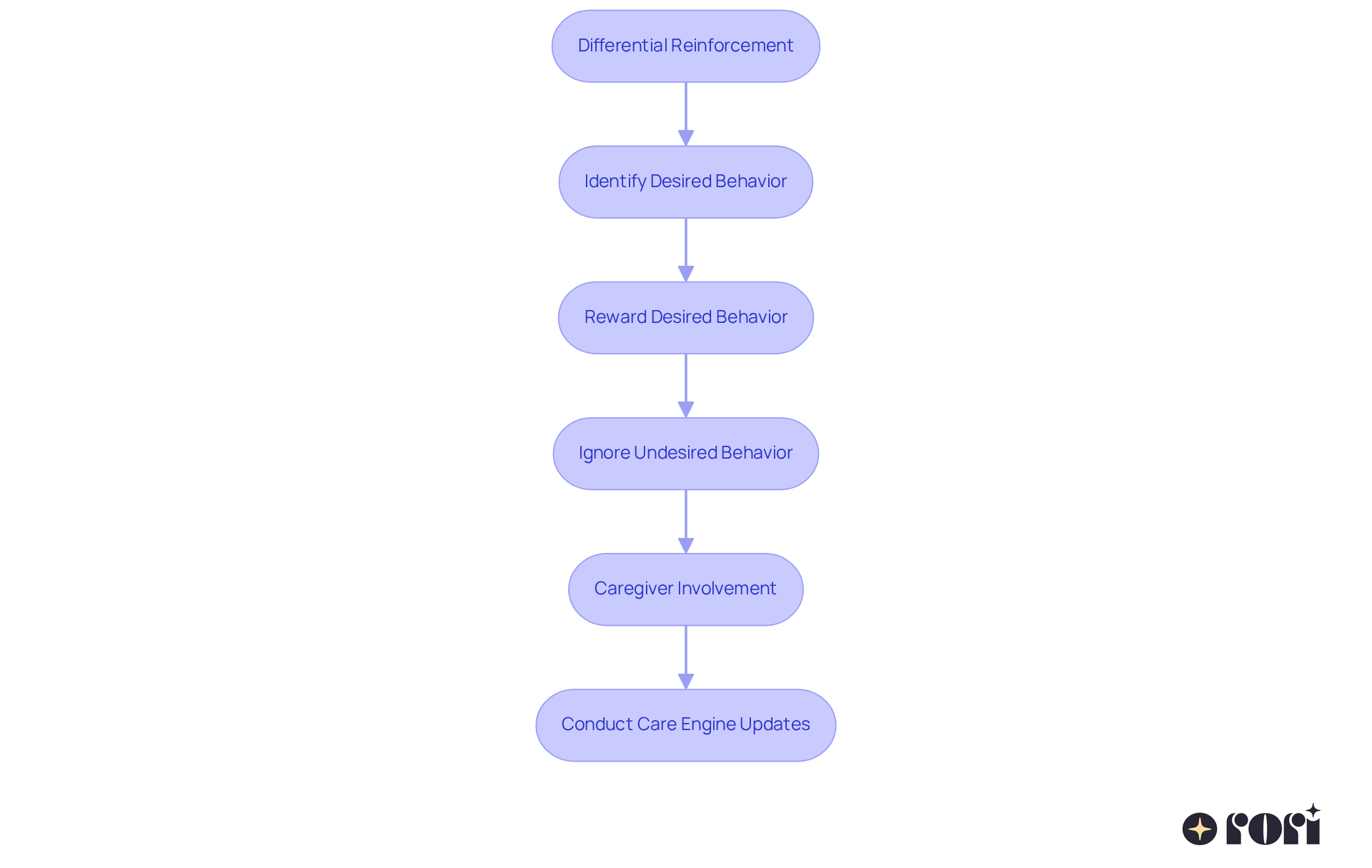
The timing of support is super important when it comes to changing behaviors. It really affects how efficiently actions are learned and repeated. When reinforcement happens right after the desired action, it strengthens the link between the action and its benefit. For instance, if a child gets praise right after sharing their toys, they’re more likely to do it again! 🌟
Studies show that prompt incentives can boost task performance by optimizing attention distribution, with an average effect size (Cohen’s d) of 0.56 for behavioral differences between immediate and postponed incentive conditions. On the flip side, delayed rewards can weaken this connection, making it less effective.
As Guang Zhao points out, immediate rewards lead to a larger P300 amplitude than delayed rewards, which means they really enhance cognitive engagement in the task. Understanding these dynamics helps caregivers, especially those educated in ABA principles, to apply more effective encouragement strategies that include ABA reinforcement examples, tailored to the needs of children with autism. This active involvement not only promotes positive behaviors and skill development but also complements professional interventions.
It’s all about creating consistency and informed decision-making to support your child's growth. Let’s explore this together! 💪
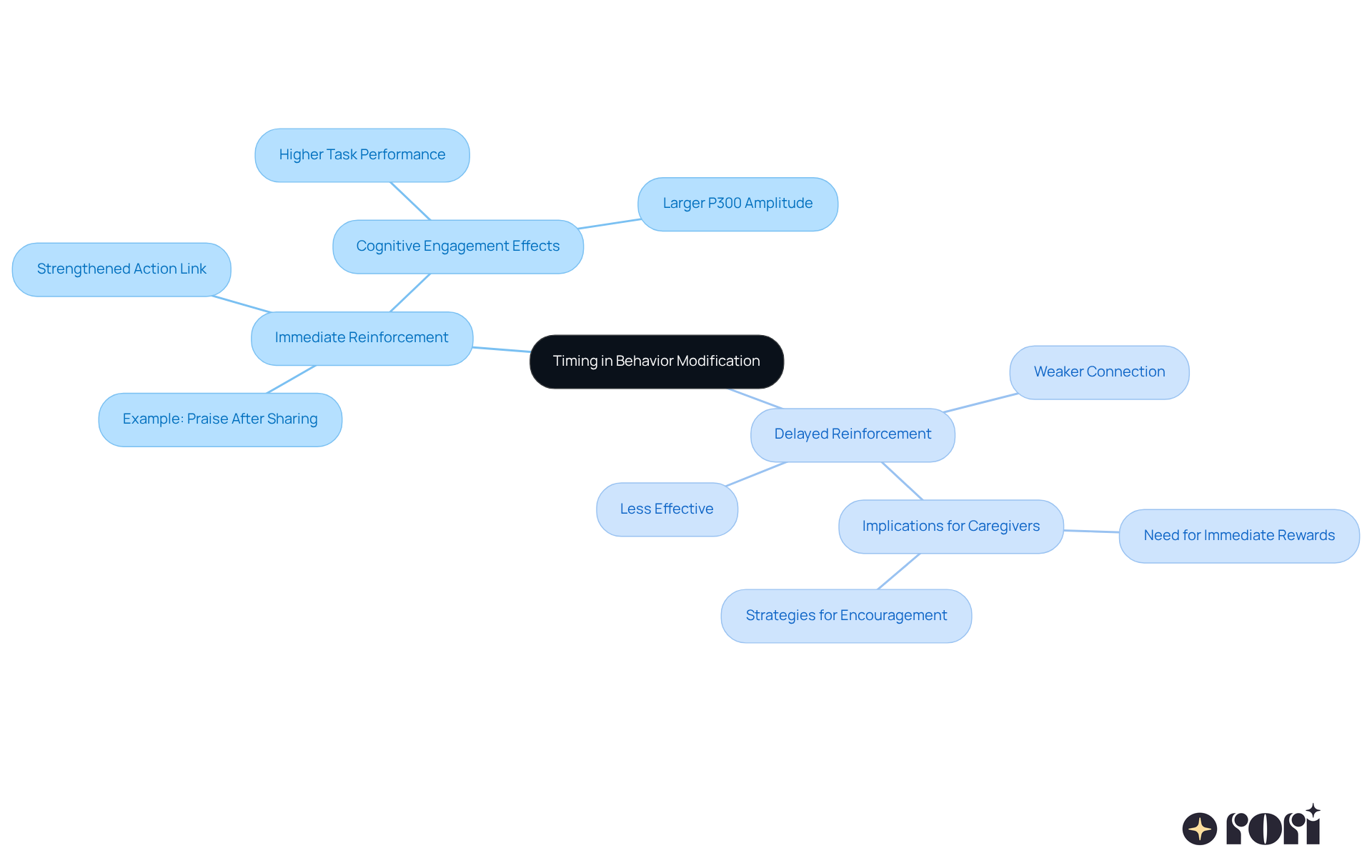
Aba reinforcement examples demonstrate how reinforcement schedules act as helpful guides that determine when and how often rewards are given, playing a key role in shaping our actions. You can think of these schedules as either continuous, where every time a desired action happens, there's a reward, or intermittent, where rewards come at certain intervals. For example, a child might earn a sticker each time they finish a task with a continuous schedule, while an intermittent schedule could reward them after every five tasks completed.
Effectively using aba reinforcement examples is crucial for maintaining those changes in actions over time. Early on, ongoing support is especially impactful, creating a clear connection between the action and its positive outcome. Research shows that individuals in continuous reward situations are almost twice as likely to exhibit preferred behaviors, like submitting negative drug tests, compared to those in sporadic reward conditions, which are common in aba reinforcement examples. But as behaviors become more established, incorporating aba reinforcement examples such as sporadic rewards can help with long-term sustainability. This not only decreases reliance on rewards but also nurtures intrinsic motivation.
The timing of rewards is really important for modifying behavior. For instance, fixed interval schedules, which provide rewards after a set period, can lead to a 'scalloped' response pattern—where activity ramps up as the reward time approaches. On the flip side, variable interval schedules encourage steady response rates, easing anxiety about when rewards will come and helping maintain consistent performance. It’s also vital to gradually transition between reward schedules, which are illustrated in aba reinforcement examples, to help individuals adapt smoothly to changing expectations.
At Rori Care, we truly believe in the power of adaptive treatment plans that are shaped by progress report data and active caregiver involvement. Our conduct care engine uses AI-driven progress report automation to tweak intervention and skill acquisition plans after each session based on what’s been achieved, ensuring that support strategies fit each individual’s unique needs. Research indicates that significant progress is seen in 90% of children when recommended hours are fully implemented with active caregiver involvement. B.F. Skinner, a pioneer in psychological analysis, pointed out that 'the manner in which positive encouragement is administered is more significant than the quantity.' This really highlights how important it is to apply reward schedules thoughtfully, ensuring they are meaningful and effective. By understanding and applying aba reinforcement examples, practitioners can create strong change programs that lead to lasting results. Let’s explore this together!

Working together with caregivers is so important for enhancing support strategies in ABA therapy! When parents and caregivers actively join in the ABA reinforcement examples, they can provide consistent feedback and support for those positive actions. For example, when a little one gets praised at home for finishing homework, it really strengthens the same behaviors encouraged during therapy sessions. This collaboration not only makes the learning experience richer for the child but also allows families to play an active role in their development, leading to more effective and lasting changes in behavior.
Research shows that when families participate actively, it significantly boosts skill acquisition and promotes consistency in behavioral improvements. Engaging families acts as a catalyst for achieving better developmental outcomes for individuals with autism. Therapists have noticed that when families are involved, the chances of successful behavior modification go up, as caregivers can reinforce those learned skills in real-life situations. This collaborative approach creates a nurturing environment where children can truly thrive.
The benefits of caregiver education further enhance this collaboration. Caregivers who understand ABA principles and strategies can make informed decisions that positively impact their child's progress. This knowledge boosts their confidence, reduces stress, and improves overall family dynamics. Therapists emphasize the importance of family participation:
Ultimately, weaving family collaboration into ABA reinforcement examples not only makes ABA therapy more effective but also fosters a sense of ownership and hope within families, encouraging ongoing effort and resilience in their loved one's journey. To get the most out of these benefits, caregivers should regularly connect with therapists about their child's progress and the strategies they're using at home. Let’s explore this together!
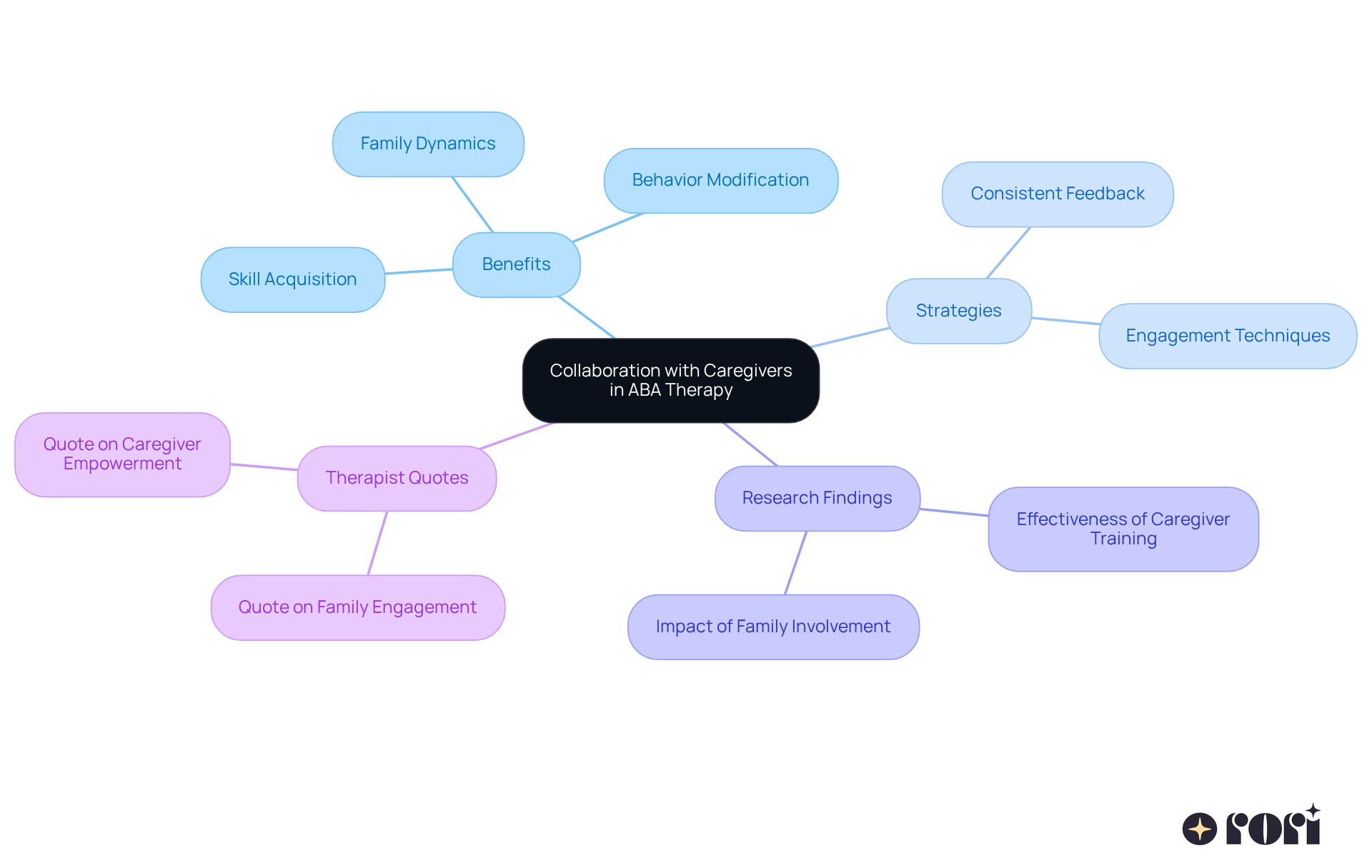
Exploring ABA reinforcement examples reveals just how impactful personalized strategies can be in encouraging positive behaviors in children. When caregivers and therapists tailor reinforcement techniques to match each child's unique preferences and needs, they create an environment that not only motivates but also nurtures lasting behavioral change. Understanding each child's individual triggers and interests is key to providing effective and engaging support.
Throughout this article, we've highlighted various reinforcement strategies, like:
These methods show how immediate and well-structured incentives can significantly boost a child's motivation and engagement. Plus, the role of caregivers in this journey is so important! Their active involvement and grasp of ABA principles are essential for reinforcing positive behaviors, both at home and in therapy.
In closing, the collaboration between caregivers and therapists is truly vital. By working together and keeping communication open, families can create a consistent and nurturing environment that supports their child's growth. Embracing these ABA reinforcement examples empowers children to thrive and lays a strong foundation for future success. It’s crucial for caregivers to actively participate in this journey, ensuring that reinforcement principles are applied consistently and meaningfully. Together, we can pave the way for lasting positive change! Let’s explore this journey together!
What is the focus of Rori Behavioral Innovations' ABA therapy?
Rori Behavioral Innovations focuses on personalized support strategies in ABA therapy, using thorough assessments like Functional Behavior Assessments (FBAs) to identify individual needs and triggers for challenging behaviors.
How does Rori Care enhance engagement in ABA therapy?
Rori Care enhances engagement by creating customized support strategies that resonate with the individual, such as using rewards that align with their interests, like dinosaur stickers for children who love dinosaurs.
What is the success rate of Rori Care's ABA therapy when caregivers are involved?
Rori Care sees remarkable progress in 90% of children when the recommended hours of therapy are fully implemented with active participation from caregivers.
How does Rori Care adjust its behavior intervention plans?
After each session, Rori Care's behavior care engine adjusts behavior intervention and skill acquisition plans based on the child's progress, fostering a nurturing learning environment.
What is a token economy system in the context of ABA therapy?
A token economy system is a structured method where children earn tokens for displaying positive behaviors, which they can later exchange for rewards like toys or extra playtime.
How do token economies benefit children with autism and ADHD?
Token economies boost motivation and engagement by providing immediate feedback and a clear connection between actions and rewards, helping children feel accomplished and improve their skills.
What strategies can parents use to enhance the effectiveness of token economies?
Parents can enhance token economies by modeling desired behaviors, tracking progress with visual charts, and setting up reinforcement schedules to maintain interest in the tokens.
What role does verbal praise play in ABA therapy?
Verbal praise serves as an essential reinforcement strategy that motivates children by acknowledging their positive actions, thereby boosting their self-esteem and increasing the likelihood of repeating those behaviors.
What is the recommended ratio of positive comments to criticism in ABA therapy?
The ideal ratio of positive comments to criticism is about 5.6 to 1, highlighting the importance of regular positive feedback in shaping behaviors.
How can caregivers keep verbal praise engaging over time?
Caregivers can keep verbal praise fresh by varying their phrases of praise to maintain impact and engagement, making the reinforcement process enjoyable for both the child and the caregiver.